Trichomyrmex destructor (Jerdon)

 Iran list Iran list
 Egypt list Type location India (Atta
Destructor, N.S., Jerdon, 1851: 105, worker) - no type images on
Antweb (February 2015) Egypt list Type location India (Atta
Destructor, N.S., Jerdon, 1851: 105, worker) - no type images on
Antweb (February 2015)
junior synonyms
basalis (Myrmica basalis, F Smith, 1858b:
125, worker) from Sri Lanka - see below
gracillima (Myrmica gracillima, F Smith,
1861a: 34, worker; Emery, 1877b: 369, footnote, queen & male) from Israel
- no images on Antweb (February 2015)
ominosa (Mymrmica
ominosa n. sp., and its junior synonym Myrmica atomaria
n. sp., Gerstaecker, 1859: 263, workers) from Mozambique - no
images on Antweb (February 2015)
vexator (Myrmica vexator, F Smith, 1861b: 47,
worker) from Indonesia - see below
 . .
|
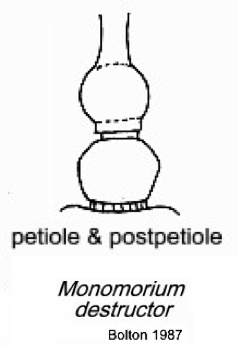 Jerdon's (1851)
description is at Jerdon's (1851)
description is at  . Gerstaecker's (1859)
descriptions of ominosa
and atomaria are at . Gerstaecker's (1859)
descriptions of ominosa
and atomaria are at  ; the sole difference in these brief
description appears to be the size. Emery (1877b: 369) gave a brief
description and illustration of the British Museum specimen; this is at ; the sole difference in these brief
description appears to be the size. Emery (1877b: 369) gave a brief
description and illustration of the British Museum specimen; this is at
 . Bolton's modern
description (1987) is at . Bolton's modern
description (1987) is at 
|
WORKER - TL
3.1-3.4 mm; distinguishing features as in key
(Bolton, 1987: 324, illustrated, petiole and postpetiole only).
In addition to Bolton's illustration and my own of
Nigeria specimens (below), I draw attention to the example in the Japanese
Ant Color Image Database; from where the description reads - TL of
workers around 3 - 3.5 mm. A relatively large Monomorium
species, variable in size. Body yellowish brown to reddish brown from
head to postpetiole; gaster blackish brown. Mandibles each with 4
teeth, the basalmost sometimes obscure. Eyes large, each with around 20
facets. Median paired carinae of clypeus obscure. Metanotal groove
distinct. Propodeum with angulate posterodorsal border; the area of
petiolar insertion carinate. Ventral outline of petiole less convex
than in other species. Postpetiole 1.1 -1.2 times as long as broad.
Mesopleuron and sections of lateral surfaces of propodeum with fine
puncturation; dorsal surface of propodeum with transverse rugae.
A tramp species probably of Indian origin; Wheeler
(1922) listed it (as gracillimum) from Guinea (Mamou,
F. Silvestri). Well known as a destructive species, a nuisance in
heated buildings, gnawing into the likes of telephone cables.
|
 The photomontage
of the vexator type from
Indonesia, is collated from http://www.antweb.org/specimen.do?name=casent0008623 The photomontage
of the vexator type from
Indonesia, is collated from http://www.antweb.org/specimen.do?name=casent0008623
See also the basalis type from Sri Lanka at http://www.antweb.org/specimen.do?name=casent0010944
|
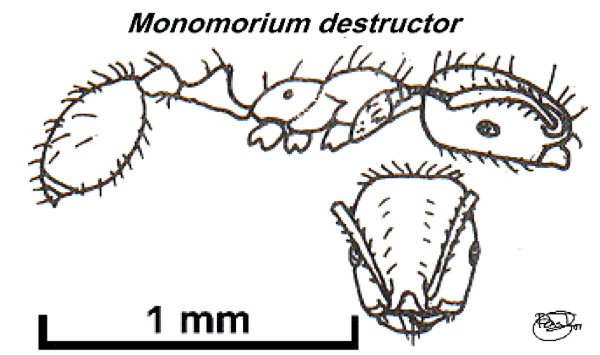 Nigeria
specimen (Monomorium species G in
Taylor, 1980a: 31).
WORKER. TL 1.90 mm, HL 0.50, HW 0.47, SL 0.34, PW 0.25 Nigeria
specimen (Monomorium species G in
Taylor, 1980a: 31).
WORKER. TL 1.90 mm, HL 0.50, HW 0.47, SL 0.34, PW 0.25
Colour dark yellow-brown, gaster near black; antennae,
tibiae and tarsi yellow; unsculptured and shiny. Erect hairs long and
moderately abundant. Clypeal carinae well developed and running into
the anterior margin of the clypeus. SI 72.
In Nigeria, my team and I found this form to be
the commonest member of the genus on cocoa at CRIN, being quite often
encountered, nesting in dead wood on living trees, and tending
Homoptera (Taylor, 1981). We also encountered it on native trees and on
kola.
Elsewhere, it was found in Ghana, on cocoa
canopy and mistletoe, as well as on open ground, at the Mampong
Cemetery farm by Room (1971). He also collected it in 18 of 168 canopy
samples in his farm survey and reported an apparent negative
association with Crematogaster clariventris and a positive
association with Oecophylla longinoda. Found on cocoa at Kade
by Majer (1975, 1976b), using pkd, with 7-9 workers per sample.
Even allowing for the variability in oscaris
described in Bolton (1987), this I find a great quandary. The colour is
quite distinctive and matches that of destructor, which was one
of the separation points given by Bolton "oscaris is uniformly
coloured, unlike destructor". However, for workers the size of
that illustrated (the only size which I encountered in quite numerous
collections at CRIN) the SI for destructor would be expected to
fall in the range SI 97-85. The puzzle is deepened by the report by
Majer (1975) of finding it in 23 of 144 25 m² pkd samples from cocoa at
Kade, Ghana; specimens were identified as Monomorium species G
by Bolton. So we had a relatively common species, clearly an arboreal
forest dweller, and yet one which could not be readily identified from
Bolton (1987).
|
Oxford University Museum
specimens
Trichomyrmex destructor
B Taylor det. |
Egypt
M Sharaf
|
13.vi.2003
Abuzabal
30°15'N
31°21'E
|
Qalobia
|
2
|
 |
Trichomyrmex destructor
B Taylor det. |
Egypt
M Sharaf |
21.vi.2003
Abuzabal
30°15'N
31°21'E
|
Qalobia
|
1
|
|
Trichomyrmex destructor
B Taylor det. |
Egypt
M Sharaf |
26.viii.2003
Port Said
31°16' N
32°18' E
|
|
3
|
 |
Trichomyrmex destructor
B Taylor det. |
Egypt
M Sharaf |
2.v.2002
Aswan
24°05' N
32°53' E
|
Saloga Is.
|
1
|
|
Trichomyrmex destructor
B Taylor det. |
Egypt
M Sharaf |
23.vii.2003
Giza
30°01' N
30°13' E
|
Brembel Atfeh
|
1
|
|
Trichomyrmex destructor
B Taylor det. |
Benin
J-F Vayssieres
RVA 3012
|
9.xi.2012
Korobourou
09°22'13'' N
02°40'16'' E
|
Mangifera indica
orchard
Quadrat 1, série 1, variété Gouverneur; ground nesting
Media worker
|
1
|
 |
Trichomyrmex destructor
B Taylor det. |
Iran
R Nafisi
23
|
23.iii.2012
36°12'N
57°40'E
|
Sabzevar-Khorasan
3206 ft
House
|
5
|
 |
|
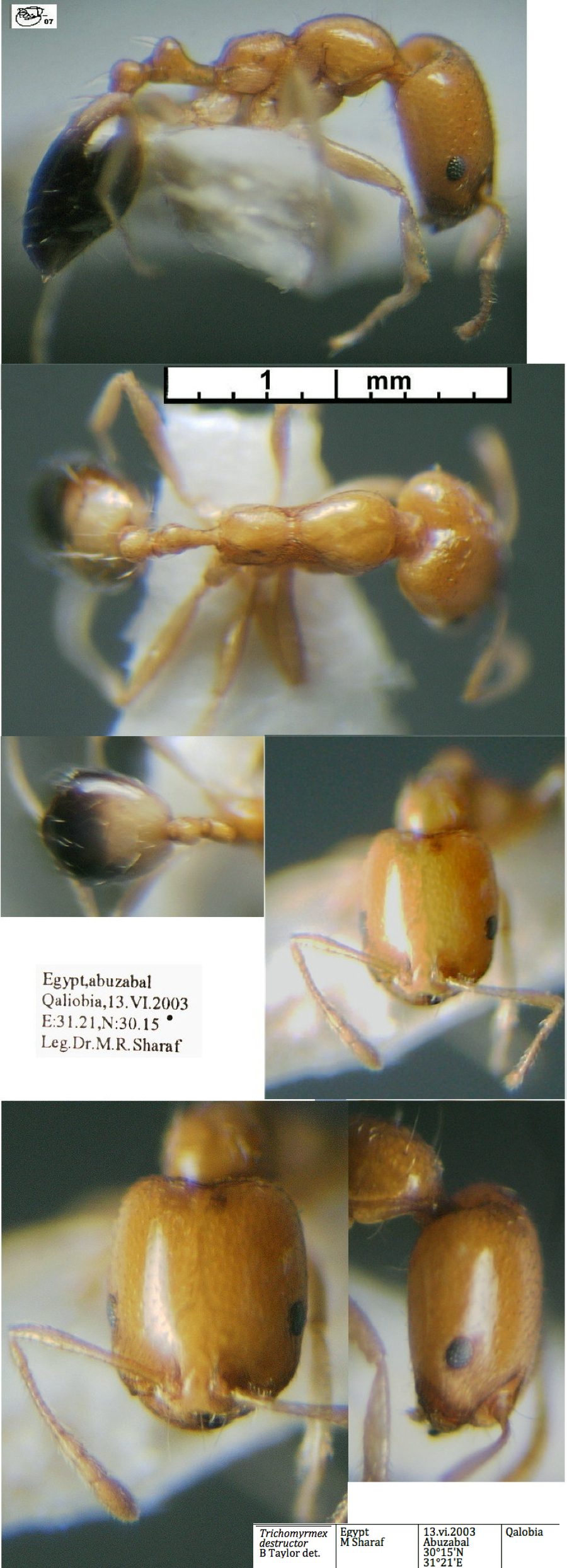 The
photomontage is of workers from Egypt, Qaliobyia,
collector Mostafa Sharaf. The
photomontage is of workers from Egypt, Qaliobyia,
collector Mostafa Sharaf.
|
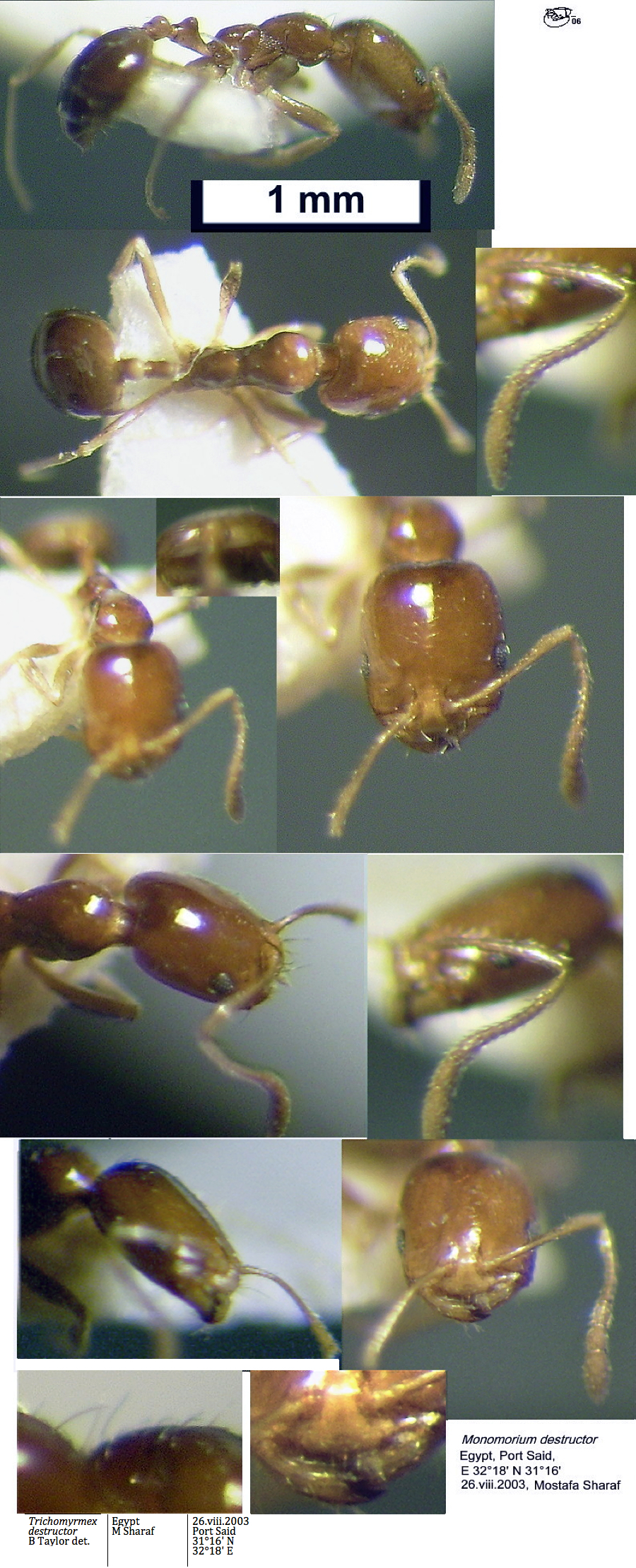 TThe
photomontage is of workers from Egypt, Port Said, collector
Mostafa Sharaf. TThe
photomontage is of workers from Egypt, Port Said, collector
Mostafa Sharaf.
|
 The
photomontage is of a worker from Benin, Korobouro, collector
J-F Vayssieres (RVA 3012). The
photomontage is of a worker from Benin, Korobouro, collector
J-F Vayssieres (RVA 3012).
|
 Iran
finding - the photomontage is of a major worker collected by R
Nafisi (23), Sabzevar-Khorasan, 23.iii.2013. Iran
finding - the photomontage is of a major worker collected by R
Nafisi (23), Sabzevar-Khorasan, 23.iii.2013.
|
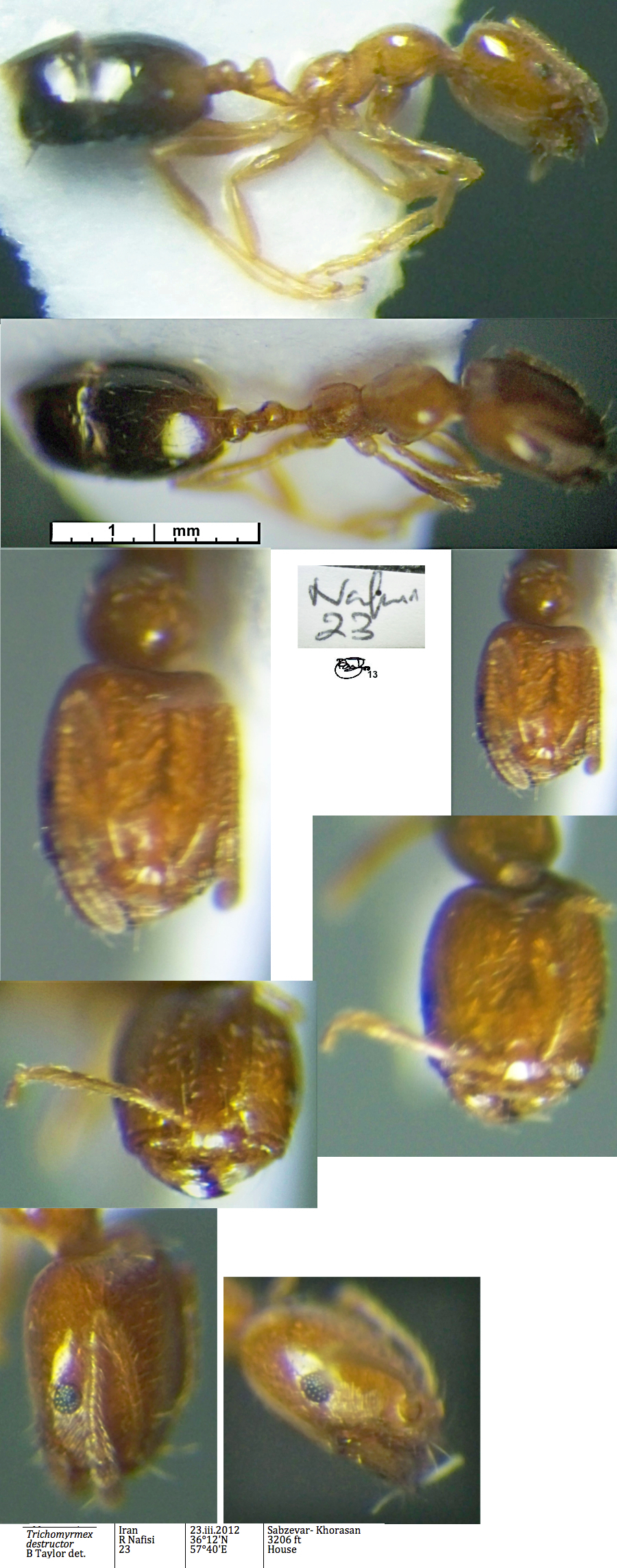 Iran
finding - the photomontage is of a minor worker collected by R
Nafisi (23), Sabzevar-Khorasan, 23.iii.2013. Iran
finding - the photomontage is of a minor worker collected by R
Nafisi (23), Sabzevar-Khorasan, 23.iii.2013.
|
Trichomyrmex destructor has the type location
India
but is described as a successful tramp species, throughout the tropical
zones and in heated temperate buildings. From Africa, Bolton examined
only specimens from South Africa, although Wheeler (1922) reported it
from Zaïre (ssp. despectum, at Sankisia, by J. Bequaert).
Generally omnivorous (Bolton, 1987).
Trichomyrmex
oscaris size range is TL 1.6-3.8 mm; the Monomorium
destructor size range is TL 1.8-3.5 (Bolton, 1987: 324). In the key
of Bolton (1987) destructor and oscaris are in the
same couplets (65, 87) and are separable on pedicel shape, the petiole
and postpetiole being rather broader in the former; oscaris also
features in a couplet (9) with emeryi but that has the head
and alitrunk all over coarsely sculptured.
Trichomyrmex
mayri is also within the group of near identical species,
separated from destructor by its being uniformly dark brown
(other characters apparently being near identical); it is recorded from
the Sahel countries of western Africa, plus across to Egypt and onwards
to West Malaysia. Now (2004), I have decided that the specimen I drew
from the CRIN collection and labelled as Monomorium species A
or F998 probably was mayri.
Bolton (1987) also preserved the species status of Trichomyrmex
epinotale Santschi.
|
 The photomontage
of a non-type queen is collated from http://www.antweb.org/specimen.do?name=casent0272010 The photomontage
of a non-type queen is collated from http://www.antweb.org/specimen.do?name=casent0272010
|
 The photomontage
of a non-type male is collated from http://www.antweb.org/specimen.do?name=casent0246602 The photomontage
of a non-type male is collated from http://www.antweb.org/specimen.do?name=casent0246602
|
|
![]() . The main
characteristics Emery listed were - slightly dimorphic workers;
funiculus with a three-segmented club (Monomorium santschii with
four segmented-club, type location Tunisia), the first two segments
equi-sized.
. The main
characteristics Emery listed were - slightly dimorphic workers;
funiculus with a three-segmented club (Monomorium santschii with
four segmented-club, type location Tunisia), the first two segments
equi-sized.